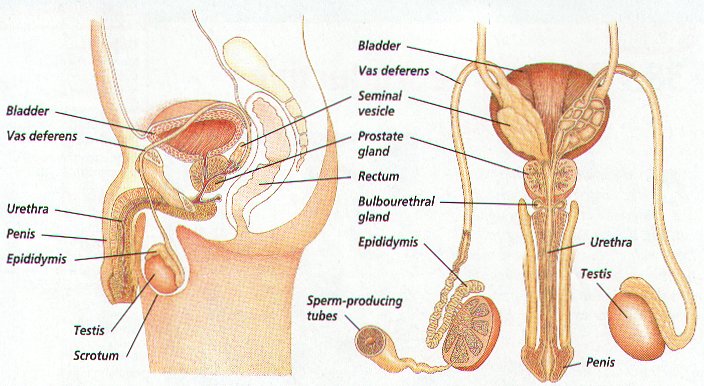The male reproductive system consists of many different parts and structures which are all equally important. The task of the reproductive system in men is to produce male sex hormones and to make, preserve and carry the sperm as well as the semen. It is responsible for discharging sperm into the female reproductive tract and fertilizing an egg. As for male reproductive system, front side is not as much debated as its side. In this article, both external and internal parts are included in the male reproductive anatomy. Read on to learn more.
Male Reproductive System—the External Organs
When looking at the male reproductive system, front side is where the external organs are located. The external organs of the male reproductive anatomy are the penis and the scrotum.

1. Penis
It is the male organ used during sexual intercourse. The root, the body and the glans are the three key parts that make up the penis.
- The root is attached to the abdominal wall.
- The body which is also known as the shaft has a cylindrical shape and is made up of three circular chambers all of which are composed of sponge-like tissue. These tissues have many large spaces in which blood fills up when the man gets sexually aroused. The penis becomes rigid as blood fills up in it and an erection is achieved which helps in penetration during sexual intercourse. The elasticity of the penis's skin allows it to enlarge when it gets erected.
- The glans is the head of the penis which is shaped as a cone. It is covered with foreskin, which is a lax layer of skin. Semen and urine are both transported through the urethra which opens at the penis's tip.
2. Scrotum
It is the pouch of lax skin that lies at the back of the penis and just below it. A number of blood vessels and nerves are located inside the scrotum which also contains the testes as well. The scrotum is responsible for maintaining the testes at a slightly cooler temperature than the rest of the body which is necessary for normal sperm development.
Male Reproductive System—the Internal Organs
For male reproductive system, front side organs or the external organs are important, but there are much more than that. Now let's take a look at the internal organs.
1. Testicles
Testicles are present in the scrotum. They are oval in shape and have the task of producing testosterone, which is the male sex hormone required for sperm generation. The seminiferous tubules are coiled tubes inside the testes which produce sperm cells. There are two testes present in most men.
2. Epididymis
It is the coiled tube lying on the back of the testes. The epididymis performs the task of storing and transporting sperm cells and also maturing them too as the sperm produced by the testes is not mature and can't be used for fertilization. Sperm is forced into the vas deferens caused by contractions during sexual arousal.
3. Vas deferens
This is the muscular tube that connects the epididymis and the pelvic cavity and winds up just behind the bladder. It is responsible for transporting the matured sperm to the urethra just before ejaculation occurs.
4. Urethra
Urethra is a tube that is mainly responsible for carrying urine out of the body. In men, the urethra is also responsible for ejaculating semen when an orgasm is reached. During sexual intercourse when the penis is erect, the urine flow to the urethra is blocked so that only semen can be ejaculated through it.
5. Seminal Vesicles
These are pouches which are attached to the vas deferens. They are responsible for producing a fluid that is rich in fructose. This fluid provides the sperm the energy to move forward. The fluid produced by the seminal vesicles forms the bulk of the ejaculate volume.
6. Prostate Gland
The prostate is shaped like a walnut which is present in front of the rectum and under the urinary bladder. This gland is responsible for producing a fluid that nourishes the sperm. The urethra passes right through the middle of the prostate gland.
7. Bulbourethral Glands
These structures are about the size of a pea and located on the urethra's side. They are responsible for producing a fluid which enters directly into the urethra. This fluid does the job of lubricating the urethra. It also neutralizes any acidity caused by urine drops that are still present in the urethra.
How Does the Male Reproductive System Work?
Now we have known the whole male reproductive system, front side and back sides, we should learn more about how this system works. When a man reached the age of puberty, the hypothalamus starts producing extra amounts of GnRH (gonadotrophin-releasing hormone). This results in a hike in production of follicle-stimulating hormone (FSH) and luteinizing hormone (LH) by the pituitary glands. Release of LH in the blood signals the testicles to begin releasing testosterone, the key male hormone.
Testosterone and FSH both signal the testes to generate sperm. It takes about 65 to 75 days to form a single sperm cell and each day around 300 million of them are produced. The seminiferous tubules present inside the testes make the sperm while the epididymis stores it.
The epididymis opens into the vas deferens which transports the sperm to the penis. Accessory sex glands are present around the vas deferens, which produce fluids when ejaculation occurs. The fluids combine with the sperm to form semen which is then passed into the urethra.
The penis becomes enlarged when a man is sexually aroused as extra blood flows into it making it rigid. The contractions result in ejaculation and release of semen.
